Physical Address
304 North Cardinal St.
Dorchester Center, MA 02124
The spleen is the most commonly injured organ in blunt abdominal trauma. , It receives 5% of the cardiac output, accounts for 25% of the total reticuloendothelial cell mass, and plays a major role in clearing the plasma antigens. Recognition of this fundamental role in the immune response during the last century has led to greater efforts to preserve the spleen after injury. Nonoperative management is now widely accepted in carefully selected, hemodynamically stable patients. Development of sophisticated and accurate diagnostic imaging techniques, such as multislice computed tomography (CT), has been a major driving force behind these changes. The accurate diagnosis of splenic injury has therefore assumed an increasingly important role in the evaluation of the traumatized patient. It is very difficult to exclude solid organ injury in patients with blunt abdominal trauma without CT. CT greatly facilitates selection of patients who are treated nonoperatively by allowing accurate identification and characterization of splenic injuries as well as of other associated injuries. , Both CT and ultrasound are important in the immediate follow-up of these patients, although ultrasound may fail to demonstrate injury in the absence of hemoperitoneum.
Imaging of patients with abdominal trauma is secondary to initial resuscitation efforts and clinical evaluation. Although plain films are part of most standard trauma protocols, the appropriateness of cross-sectional imaging depends on the clinical situation. Hemodynamically unstable patients or individuals with critical nonabdominal injuries that require immediate attention are not suitable candidates for CT and are typically evaluated by diagnostic peritoneal lavage (DPL) or are explored immediately. , However, in hemodynamically stable patients, imaging can play an invaluable role in detecting and staging splenic injury. Imaging can also be useful in the follow-up and postoperative evaluation of these patients.
CT has become the “gold standard” for the diagnosis of splenic injuries after trauma. CT has an accuracy exceeding 95% in the detection of splenic injuries. However, these impressive results can be obtained only by use of meticulous CT technique. Streak artifacts from the patient’s arms, external wires and hardware, nasogastric tubes, and gastric distention or gastric air-fluid levels should be avoided or minimized. Contrast-enhanced multislice CT is the current method of choice for evaluation of trauma patients with suspected abdominal injury in most institutions. Multislice CT scanning with bolus technique is preferred to optimize injury detection and to minimize delay within the department. , Multislice scanners with fast tube rotation minimize the scanning time and motion artifact. , ,
Assessment of splenic injury should include evaluation for hematoma, extent of laceration, active extravasation of contrast material, and associated vascular injuries. Splenic hematomas are hyperdense relative to the splenic parenchyma on unenhanced CT and generally hypodense on contrast-enhanced CT. Splenic hematomas may be intraparenchymal, subcapsular, or perisplenic. Intrasplenic hematomas ( Fig. 63.1 ) typically appear as hypodense areas within the splenic parenchyma after administration of contrast medium. , , These intrasplenic hematomas may be nearly isodense in some cases, particularly after inadequate administration of contrast material. ,
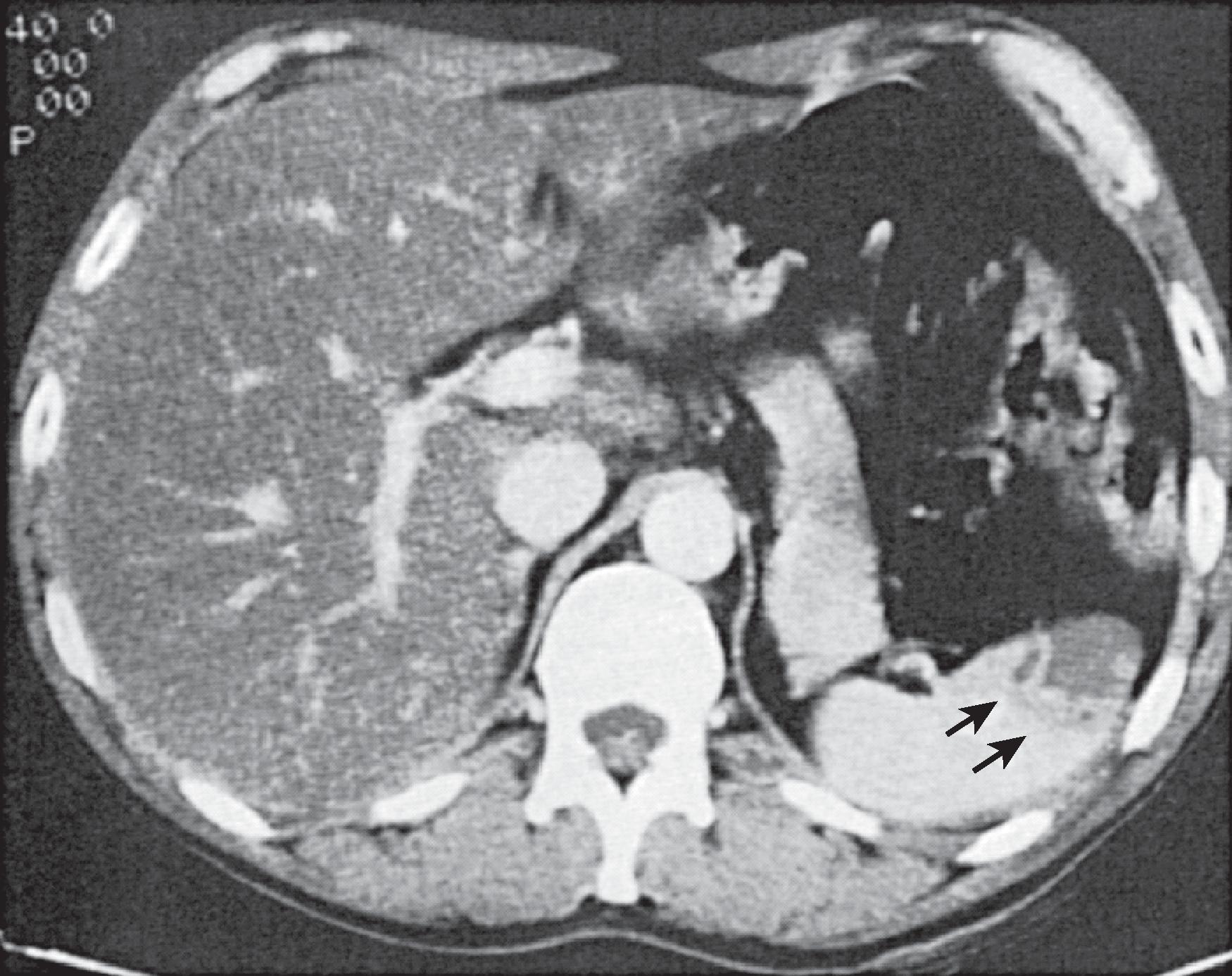
Splenic lacerations on CT appear as linear, low-attenuation foci that may not extend completely across the spleen. Lacerations may be single, multiple, or stellate ( Fig. 63.2 ). Splenic fractures ( Fig. 63.3 ) are defined as lacerations that extend completely across the splenic parenchyma and commonly involve the splenic hilum. Intraparenchymal lacerations become smaller and less dense with smoother margins over time. This healing may take weeks, and follow-up CT, particularly in the setting of an uncomplicated clinical course, is not helpful and does not affect management. , Follow-up imaging after hospital discharge is not advocated by many centers.
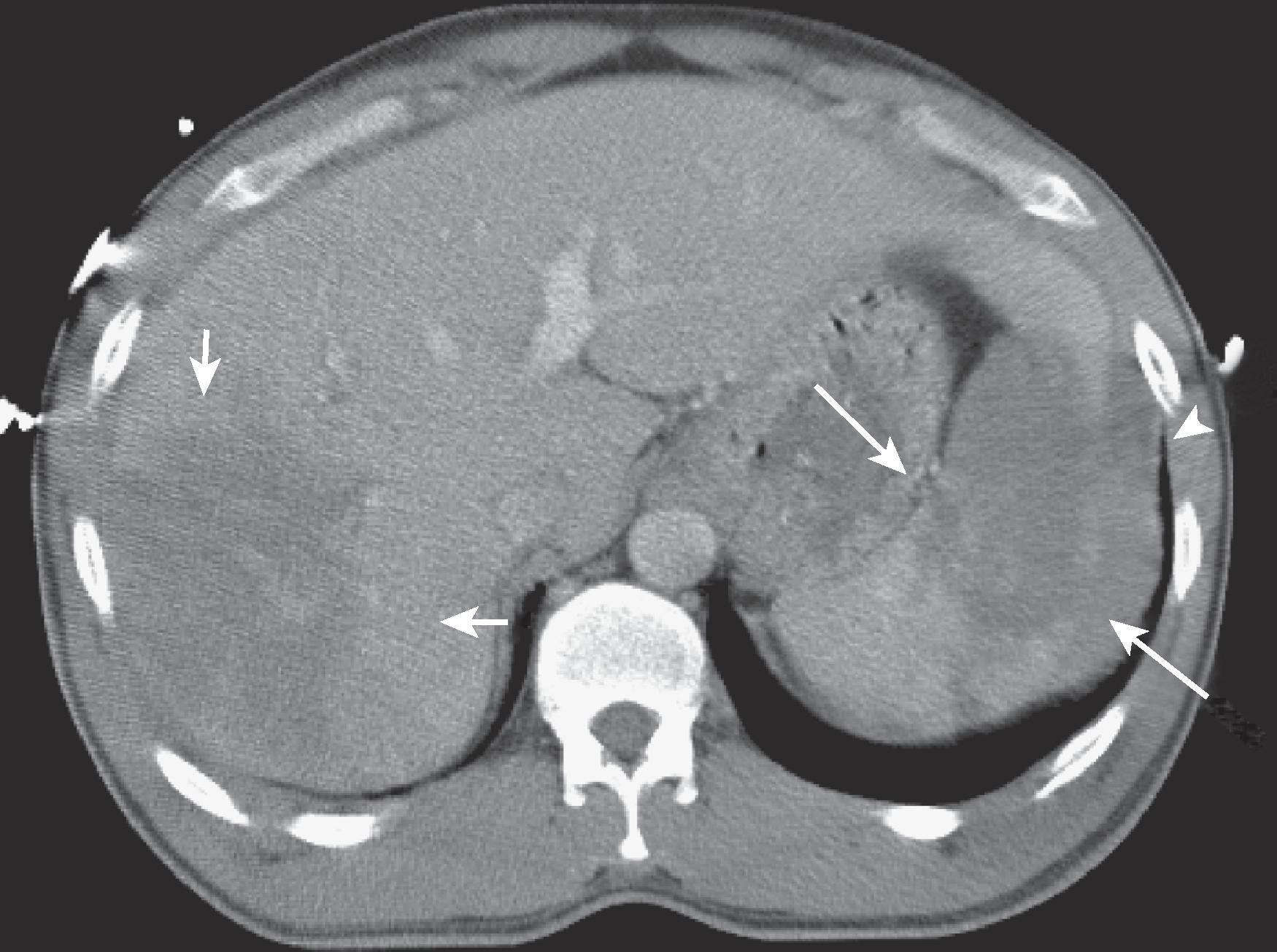
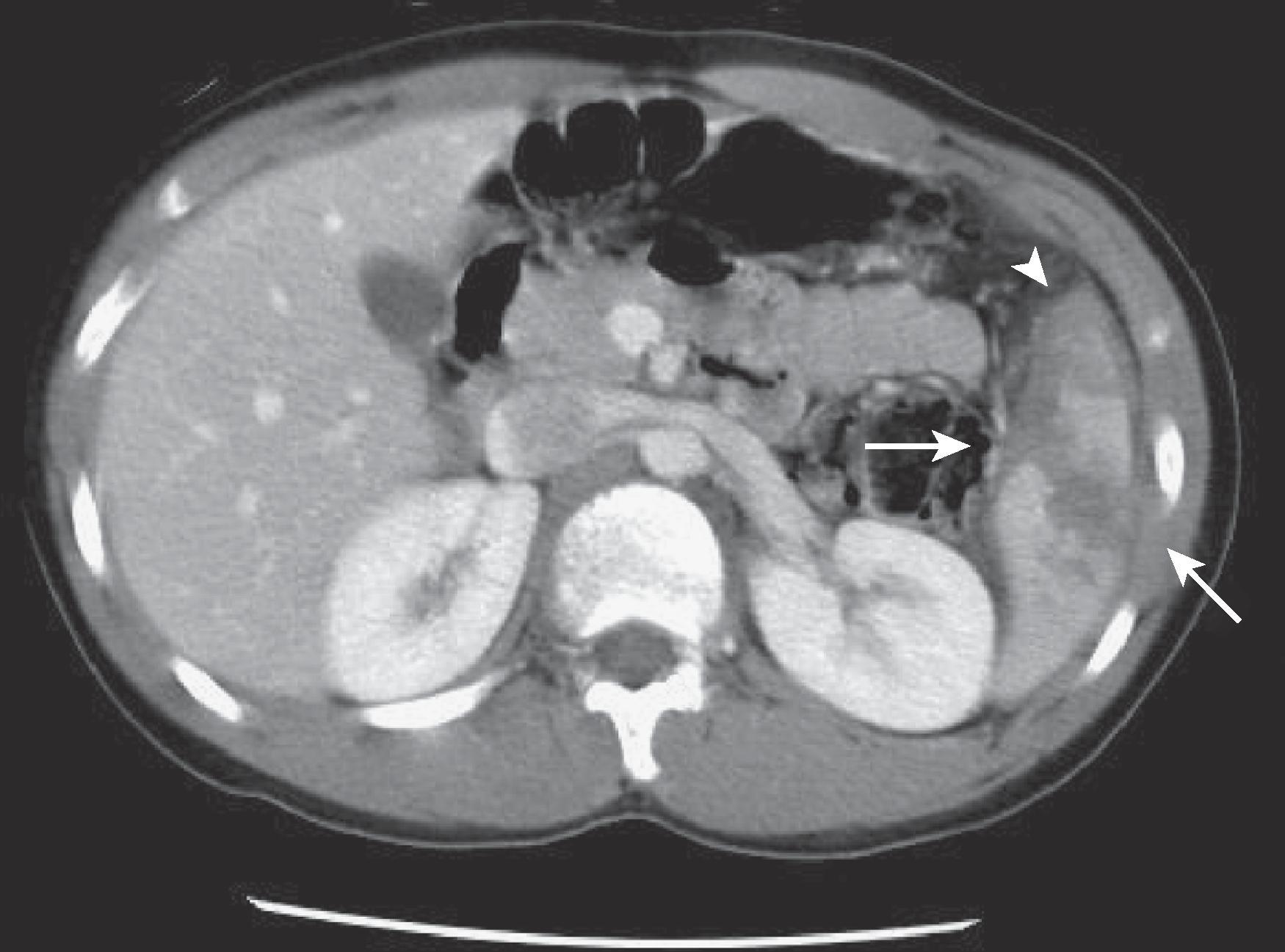
Subcapsular hematomas follow the splenic contour and compress the parenchyma. Subcapsular hematomas ( Fig. 63.4 ) typically appear as crescentic fluid collections along the lateral aspect of the spleen, which may be difficult to distinguish from perisplenic fluid. These hematomas become less dense over time and may mimic free intraperitoneal fluid. However, mass effect on the splenic parenchyma and its location between the enhancing capsule and the parenchyma distinguishes it from free fluid. Subcapsular hematomas usually resolve within 4 to 6 weeks. These hematomas are not associated with delayed splenic rupture and are not an indication for splenorrhaphy.
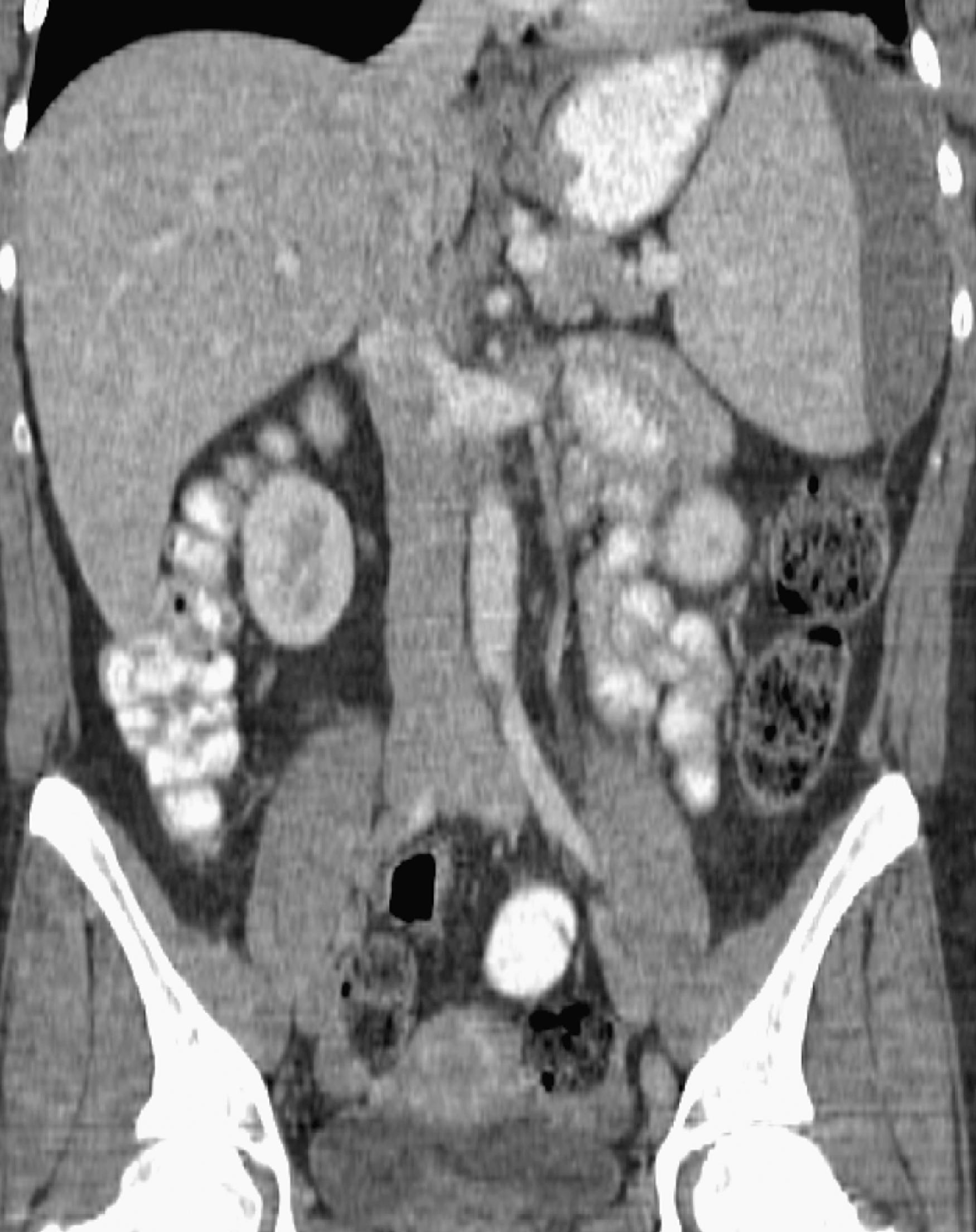
Severe disruption of the splenic parenchyma results in a “shattered” spleen ( Fig. 63.5 ). Vascular pedicle injuries usually result in significant hemorrhage and cardiovascular instability and are usually not referred for CT evaluation. These patients do have a characteristic CT appearance with nonenhancement of the caudal portion of the spleen and preservation of upper pole perfusion through the short gastric arteries. Active hemorrhage appears as areas of irregular collection of contrast material that can be distinguished from adjacent clot by its density ( Fig. 63.6 ). , Extravasated contrast material has a higher mean attenuation than hematoma (132 HU vs 51 HU). In general, contrast material extravasation has a higher likelihood of splenic hemorrhage at laparotomy. , Laparotomy in these patients may be avoided by prophylactic embolization of the proximal main splenic artery. , ,
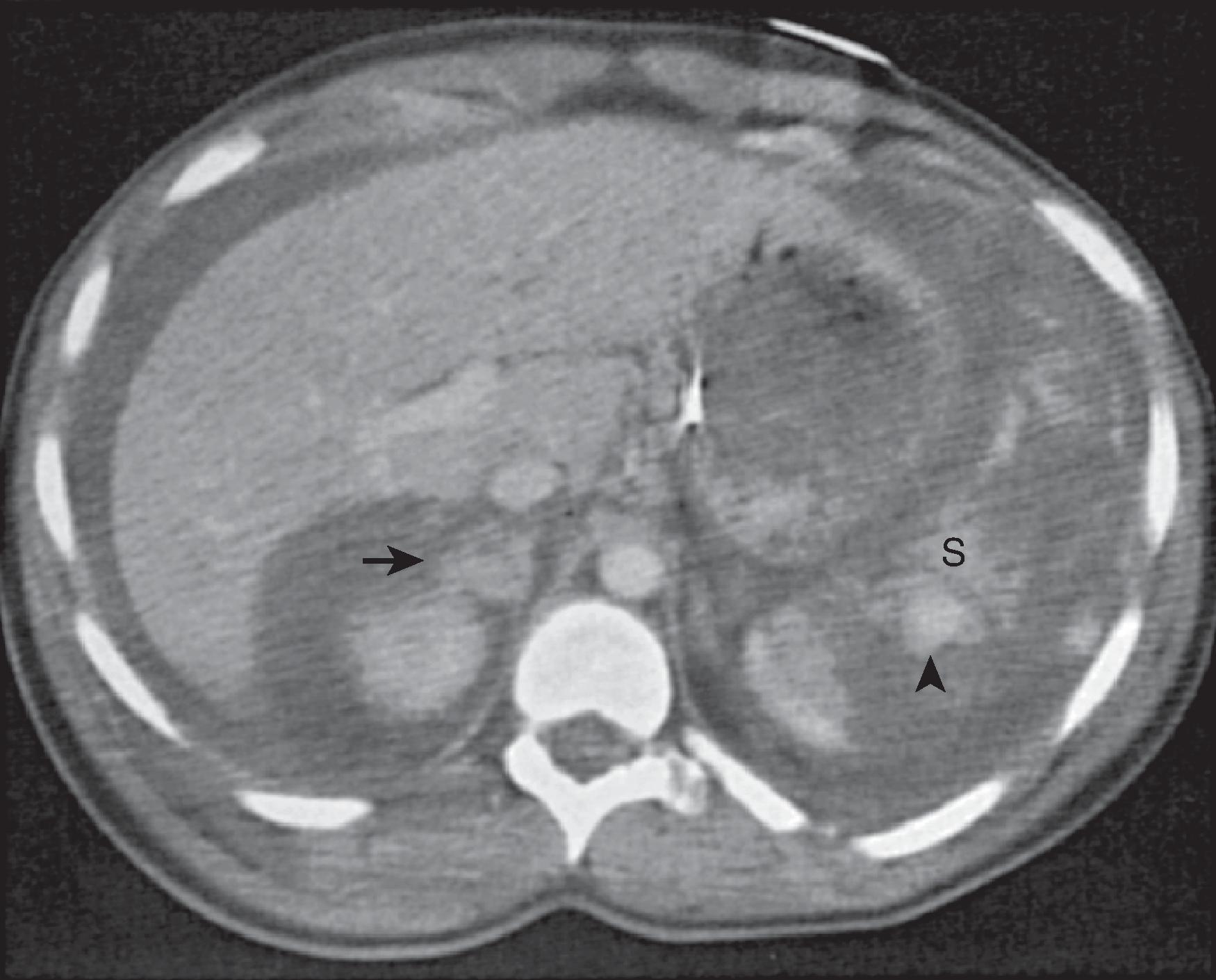
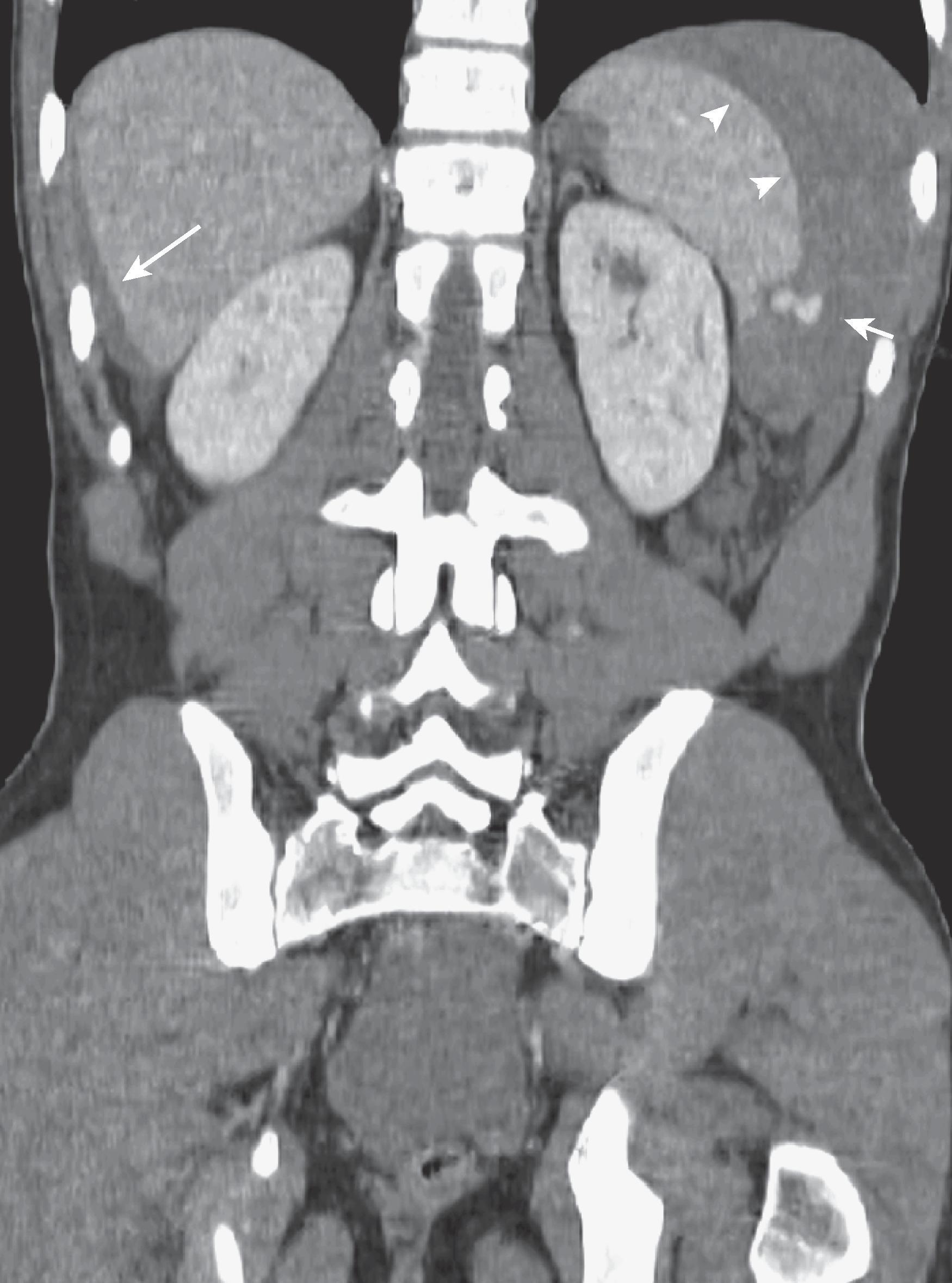
Splenic injuries may be subtle, and parenchymal or capsular lesions may not be directly visualized. The presence of perisplenic high-attenuation fluid or clot, the so-called sentinel clot ( Fig. 63.7 ), is a useful indicator of splenic injury. , In one series, 20% of patients with surgically proven splenic injury demonstrated perisplenic clot as the principal finding. Another subtle sign of limited splenic injury is thickening of the anterior renal fascia and the left lateroconal fascia, presumably from dissection of hemorrhage through the splenorenal ligament to the retroperitoneal interfascial planes.
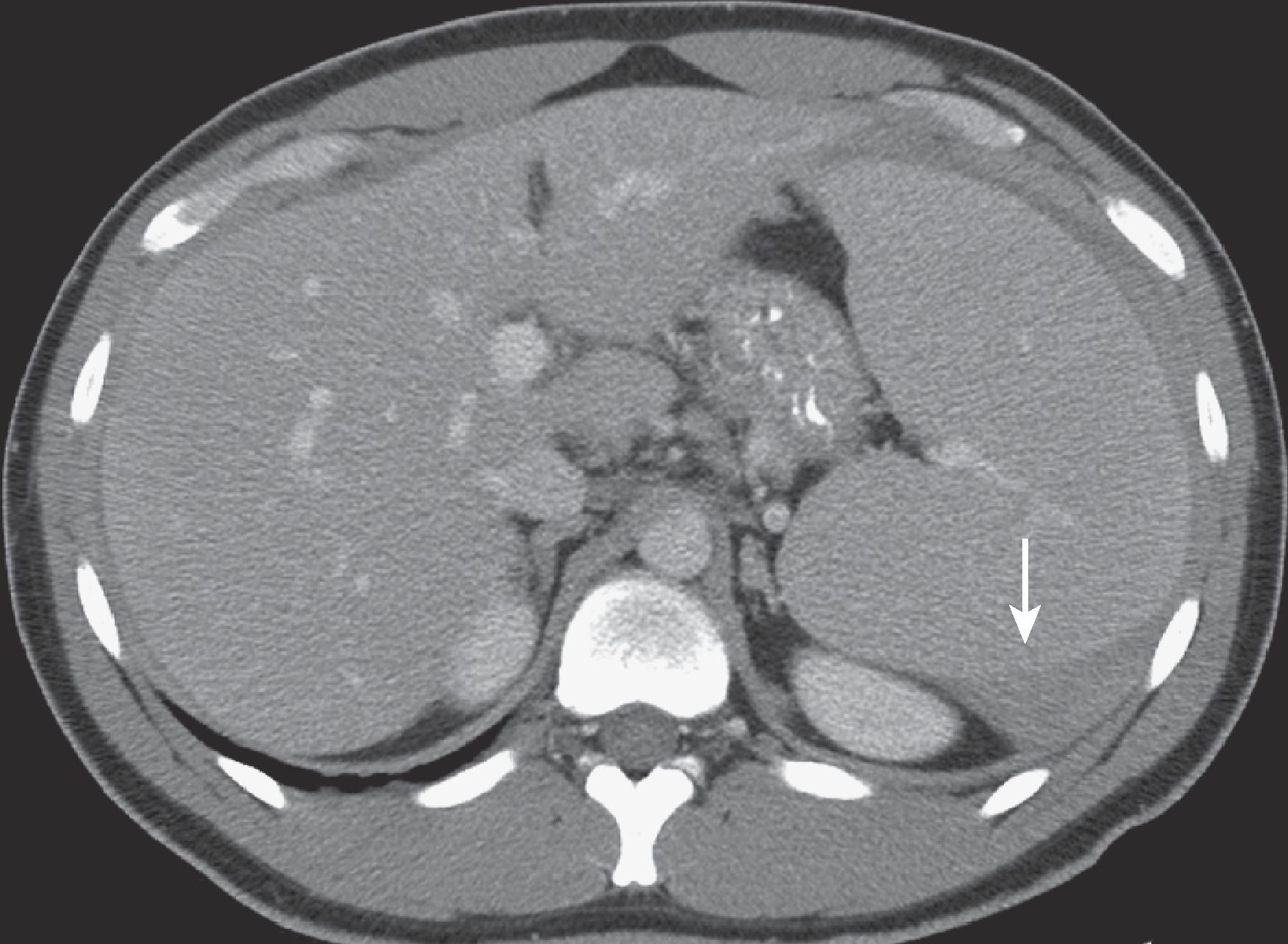
Splenic artery pseudoaneurysm is a rare but life-threatening complication of splenic injury after blunt abdominal trauma. Davis and colleagues reported well-circumscribed focal contrast blush indicative of pseudoaneurysm formation in the CT of 8% of their adult patients with blunt splenic injury. Pseudoaneurysm may also be diagnosed by ultrasound, but it has lower sensitivity than CT. The current management of post-traumatic splenic artery pseudoaneurysm in adults and children diagnosed by CT or ultrasound is not well established and ranges from conservative treatment to immediate confirmation and embolization by angiography. , , , A pseudoaneurysm may be distinguished from active extravasation of contrast material by examining the arterial and excretory phases of CT; pseudoaneurysm will become isodense to the adjacent vascular structures on delayed images, whereas active hemorrhage demonstrates no significant change in attenuation.
Significant intimal injury in the splenic artery may lead to splenic infarction. This unusual finding may be associated with splenic or other adjacent organ injury and may not be associated with significant adjacent hemoperitoneum.
The degree of injury by the Splenic Injury Scale as proposed by the American Association for the Surgery of Trauma (see later for grading of splenic injury) as well as the presence of a pseudoaneurysm must be closely evaluated. Increase in the size of linear foci on follow-up scans should alert the clinician to the possibility of progression of laceration. A hyperdense focus within the injured parenchyma after intravenous administration of contrast material may indicate pseudoaneurysm formation. As discussed previously, the role of CT in follow-up of patients with splenic injury who are hemodynamically stable and are without evidence of blood loss has not been clearly established. Many institutions obtain follow-up CT within 48 hours of the initial diagnosis to assess for possible progression of injuries. , ,
Changes in splenic size on follow-up examinations should be interpreted carefully. Splenic enlargement has been observed in stable patients after blunt trauma, which is believed to represent return to normal size after physiologic contraction. Goodman and Aprahamian reported an average 25% increase in splenic volume on follow-up CT scans in trauma patients, with more than half of their patients manifesting an average increase in splenic volume of 56%.
CT is equally useful in penetrating injuries, particularly stab wounds. CT can reveal commonly associated chest, diaphragmatic, and intra-abdominal injuries ( Fig. 63.8 ). The use of water-soluble oral and rectal contrast agents facilitates the detection of associated visceral injuries.
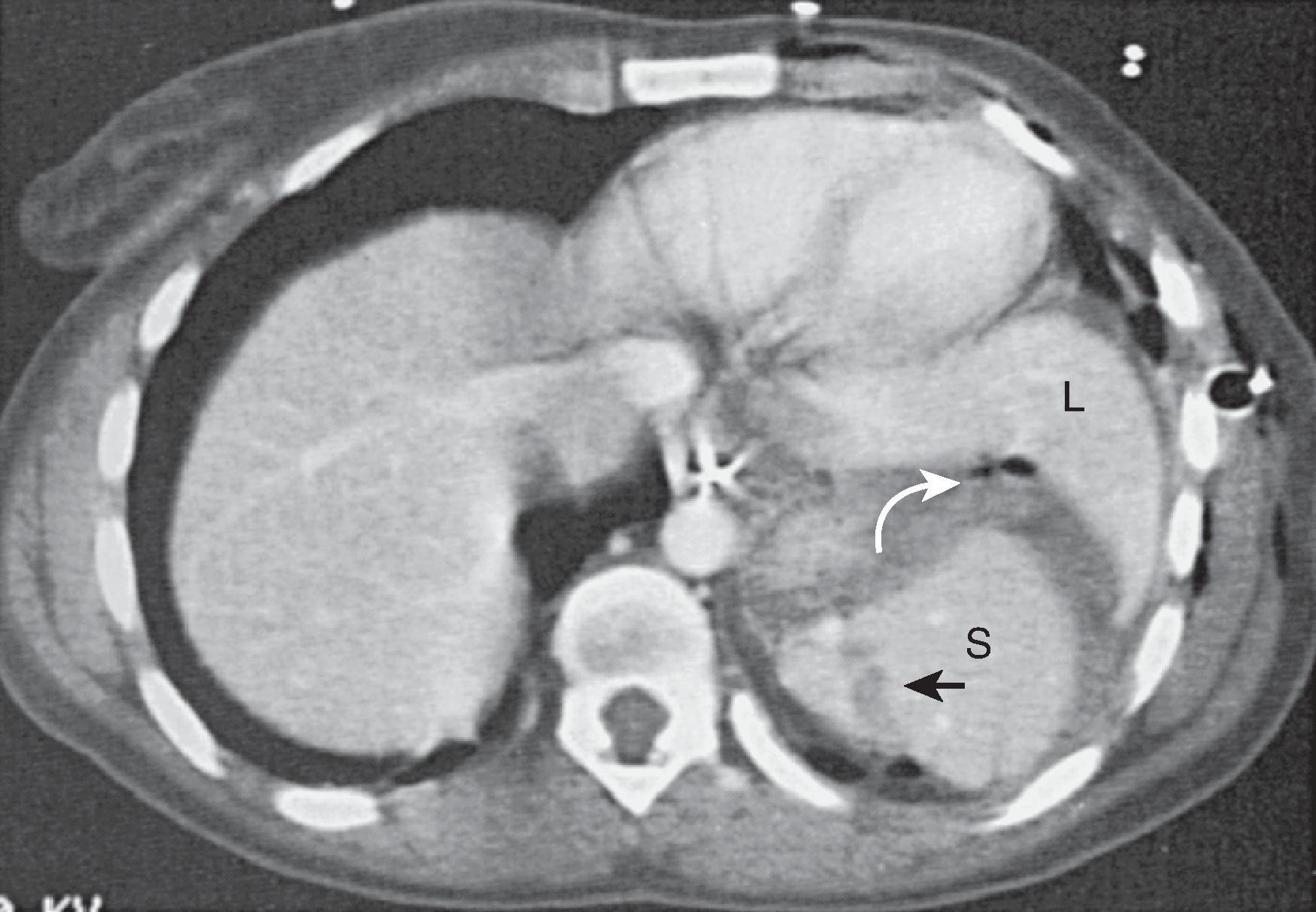
It is important to be aware of interpretive pitfalls in diagnosis of splenic injury by CT. Splenic parenchymal enhancement in normal patients usually appears heterogeneous during the early phase of scanning and should be interpreted with caution in trauma patients. Portal venous phase of enhancement optimizes splenic enhancement for evaluation of traumatic injury. Therefore, start of the scanning approximately 65 seconds after the start of contrast material injection improves hepatic and splenic enhancement. Diminished splenic enhancement relative to liver has been reported in trauma patients without splenic injury, possibly related to adrenergic stimulation and splanchnic vasoconstriction, and should not necessarily be interpreted as indicative of splenic injury or vascular compromise. ,
Significant artifact from the patient’s arms or overlying support lines may simulate splenic injury or limit its evaluation. Close attention to patient positioning is mandatory, and its importance should be communicated to the trauma team. Respiratory motion artifact mimicking subcapsular hematoma, common with older scanners, is uncommon with the latest multislice scanners. Congenital splenic clefts are common and should not be mistaken for lacerations. Clefts typically are found along the medial surface of the spleen, whereas most lacerations originate from the lateral surface of the spleen. , However, neither of these generalizations is absolute, and at times, clefts may be difficult to distinguish from a laceration.
Become a Clinical Tree membership for Full access and enjoy Unlimited articles
If you are a member. Log in here